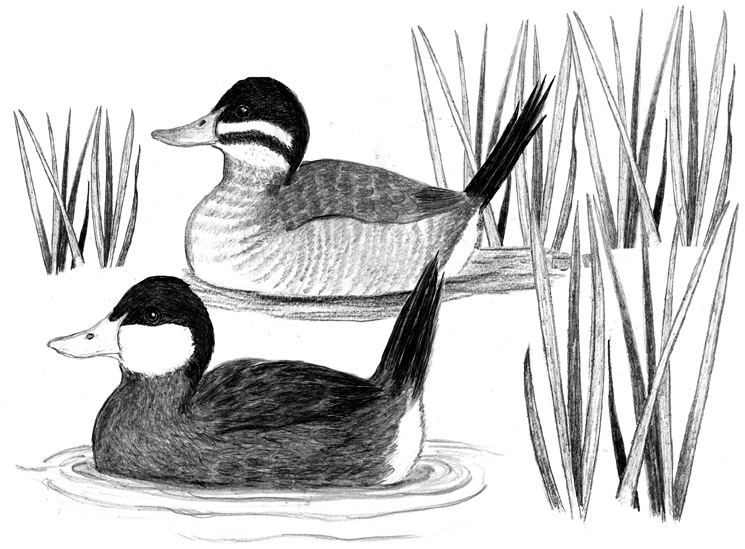
Dear Bird Folks,
I photographed this large flock (see photo) of Buffleheads swimming in Eastham’s Herring Pond last week. I would like to know why the flock is entirely made up of females. Do Buffleheads only travel in same-sex flocks?
– Erik, Eastham, MA
First things first, Erik,
No, Buffleheads don’t always travel in same-sex flocks. Male and female Buffleheads are quite often seen together. But before you show your photo to anyone else, there is something you should know. The ducks in your picture aren’t female Buffleheads, or even male Buffleheads for that matter. They are Ruddy Ducks. Really. Grab your bird book and see for yourself. Did you do it? I was right, right? Don’t feel bad about misidentifying the birds; it comes with the territory. (Not to worry, I’ll keep it just between us. No one else will ever know, except for perhaps the twelve million people who read this newspaper each week…but that’s all.)
As their name implies, Ruddy Ducks are small ducks, with rusty-red bodies, which I’m sorry to say, look nothing like Buffleheads. But here’s the thing: only males have the ruddy coloring. And even then, they are only “ruddy” during the breeding season. The rest of the year both the male and female Ruddy Ducks are dull gray/brown and could perhaps, maybe, I guess be confused with female Buffleheads. Sure, why not?
Because of our marine habitat, Cape Cod is a great place to see water birds, especially in the winter. (FYI: In this case, “winter” also includes fall and early spring.) We have everything from geese to grebes to loons, and nearly thirty different species of ducks. But I would bet most Cape Codders aren’t familiar with, or even interested in, Ruddy Ducks, which is fine with the ruddys. They aren’t interest in us, either. Ruddy Ducks are nothing like the “white bread” ducks folks feed in urban parks. They want to be left alone and the fewer humans they see, the better they like it. (I think a lot of creatures agree with them on that last point.) In addition to their aforementioned rusty-colored bodies, the breeding males have white cheeks, dark black head caps and ridiculously brilliant blue bills. Unfortunately for us, we rarely get to these pretty boys, as Ruddy Ducks are rare nesters in Massachusetts. This was not always the case, however. Records indicate that they were once regular breeders in the Bay State, but then we shot ‘em all and things changed. (Funny how that works.)
Now is the best time to look for these peculiar little ducks, but since they are rather drab this time of year (although the males still have their white cheeks), a good way to identify them is from their silhouette. Ruddys are North America’s lone member of a tribe of waterfowl known as “stiff-tailed ducks.” Similar to wrens, ruddys often cock their tails straight up, making them look as if they have a serious cowlick problem and are desperately in need of a tube of Brylcreem. (Remember that?)
Ruddy Ducks not only don’t like people, they don’t much care for other ducks either. We most often see them floating in a compact homogenous flock with few, if any, other species mixed in. While we are on the topic of their likes and dislikes, here’s something else they don’t like, walking. Because they are diving birds, their legs are set farther back on their bodies; thus, their movement on land is awkward and labored (looking like me after I’ve been sitting too long). There is also one other thing ruddys would rather not do, and that’s fly. This seems a little surprising, especially for a migrating bird. But again, because of their setback legs, takeoff requires lots of flapping and splashing. So, when Ruddy Ducks need to avoid danger, they prefer to swim away or dive below the surface. In other words, they’d rather swim and dive than flap and splash, and I don’t blame them. Diving is far more dignified than flapping and splashing.
The bulk of North America’s Ruddy Ducks breed in the wetlands of the Western prairies, Erik, so we’ll have to be content seeing them during the winter, when they look dull and maybe, according to some, a little like female Buffleheads. Just don’t feel bad about your misidentification. We all do it. Besides, things could be worse. You could be making jokes about “Brylcreem.” That would be embarrassing.
While we are the topic of ducks,
last week’s Red Sox parade in Boston got me wondering where the name “duck boat” came from, and it turns out there’s a Cape Cod connection. The amphibious vehicle, officially known as “DUKW” (hence, duck…somehow), was first produced in 1942, with the help of General Motors. Originally, the feds didn’t much care for the weird vessels. But then, the story goes, a Coast Guard patrol craft ran aground off of Provincetown. A storm prevented traditional ships from making a rescue, but one of the new duck boats, which just happened to be in the area for a demonstration, sprang into action. It easily plowed through the choppy surf and saved the Coasties. That incident convinced the government to authorize production of more duck boats for the sole purpose of routinely carrying championship teams through the streets of Boston, or so it seems.